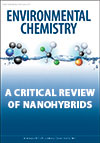EN14127A critical review of nanohybrids: synthesis, applications and environmental implications
Environmental context. Recent developments in nanotechnology have focussed towards innovation and usage of multifunctional and superior hybrid nanomaterials. Possible exposure of these novel nanohybrids can lead to unpredicted environmental fate, transport, transformation and toxicity scenarios. Environmentally relevant emerging properties and potential environmental implications of these newer materials need to be systematically studied to prevent harmful effects towards the aquatic environment and ecology.
EN14127 Abstract | EN14127 Full Text | EN14127PDF (1.2 MB) | EN14127Supplementary Material (1.1 MB) Open Access Article




